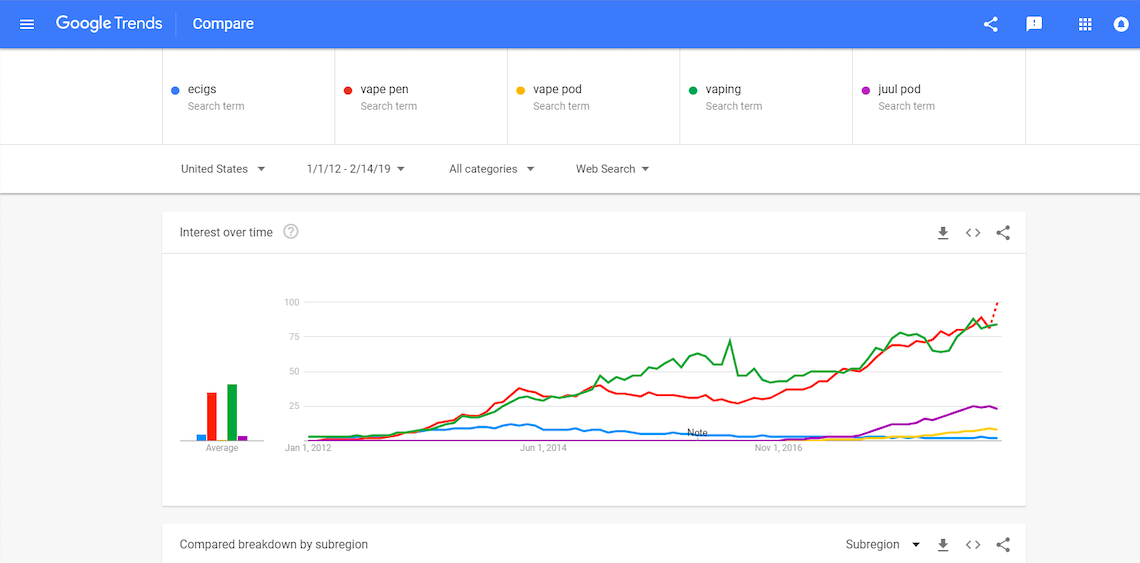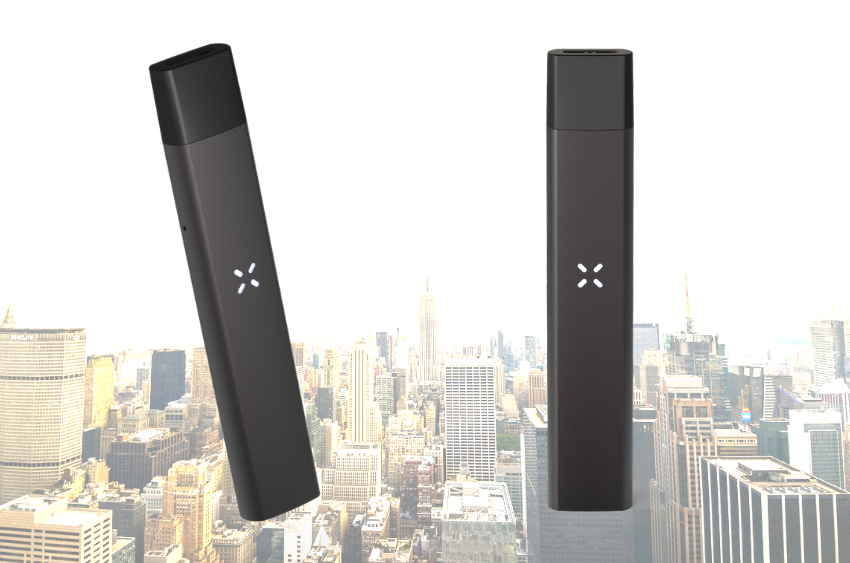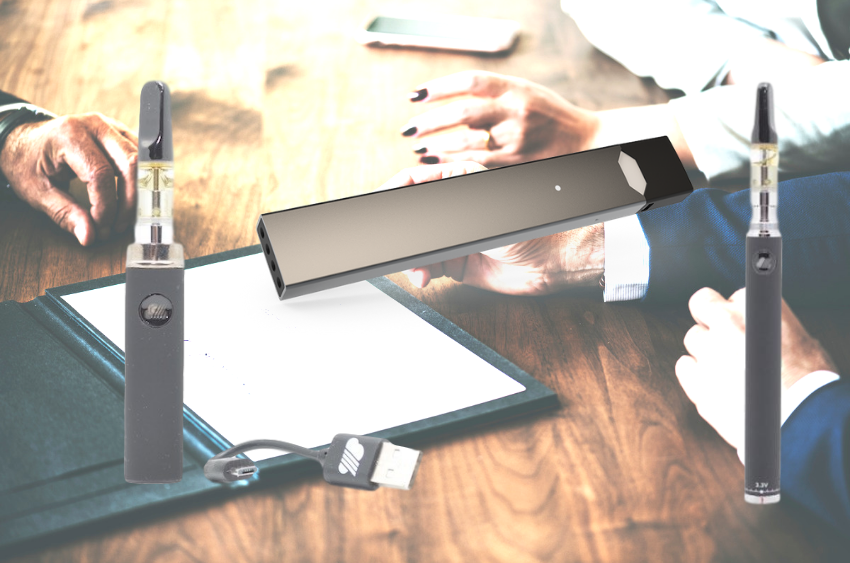E-Cig Evolution - Technology, to Marketing & Legislation
E-Cigs, aka Vape Pens, have hit the market and the popularity has grown like crazy. From the technology and innovative designs, to the marketing and legislative issues, this post breaks down the e cig market and more.
E-cigs (or, to use the more popular current search term for the devices, vape pens) have been steadily growing in popularity over the past decade. Driven in large part by their marketing as being safer than cigarette smoking, e-cig use has become increasingly widespread among a diverse demographic set of consumers.
All Types of Vapes Now
In addition to the nicotine-containing vape juices of the early and mid-2000s, vaporizers designed for other types of concentrates have emerged. The surge in popularity of these devices has led to the interchangeable use of the terms “e-cig” and “vape pen” and other related terms over the past ten years. As the perception of vaping has shifted away from a replacement for cigarette smoking and toward a concept of using high temperatures to vape any of a variety of concentrates, so too has the language we use to search for information about the topic.
Portable is Growing in Popularity
Despite the clear shift in preferred terminology, personal vaporizers have continued to grow in popularity over the past decade and are expected to grow further. Of the different styles available, the pen-style vape has become a pronounced consumer favorite, outpacing box mod vape, desktop vaporizers, and other designs.
Here, we discuss the rise of the e-cig vaporizer, how they came to be so popular, and how marketing trends have influenced public perception of e-cigarettes and vaporizers.

What Exactly Is An Ecig?
The modern e-cig vape is a general term for a device that consists of a cartridge and a heating element that produces vapor for inhalation by the user. “E-cig” is generally used to refer to a device that vaporizes nicotine, including popular current models like Blu and JUUL. Vapes can be more general and can refer to products that use both nicotine pods as well as other concentrates or dry herb materials
We tend to think of vaping as a relatively new phenomenon, but the first documented reference to an electronic cigarette device actually dates back to 1930. The device was never brought to market and may never have existed at all. The idea of electronic cigarettes went quiet for the next thirty years, until the creation of the first device that resembles the modern e cig. Patented in 1965 by Herbert A Gilbert, prototypes were created that may never have included nicotine. However, the first e cig was not brought to market until 1979 by a computer pioneer named Phil Ray. Ray also introduced the verb “vape” to the public, which long outlasted his original device.
In 2003, the first vape product to achieve commercial success was created in Beijing, China by pharmacist, inventor, and heavy smoker Hon Lik. According to sources, Lik created the vaporizer after his father, who was also a heavy cigarette smoker, passed away from lung cancer. Lik’s company at the time, Golden Dragon Holdings, developed the fledgling vape and changed its name to Ruyan, which translates to “like smoke.” Ruyan would pave the way for the success of other vape companies in the future by funding independent research that demonstrated e-cigarettes to be safer than traditional cigarette smoking
Over the years, the vaporizer has exploded into many different forms, from discreet vape pens to the box mods that produce dense, heavy clouds and every possible incarnation in between. The box mod is a popular type of advanced battery e-cig that can be reused again and again and lasts for long periods, even at high voltages. These models use refillable vape tanks for e-liquids or concentrates and rose in popularity along with things like vape tricks and the interest in dense, heavy clouds of vapor
Pen-style vapes have overtaken box mods in popularity in recent years, becoming the standard product among consumers and in internet searches. Some pen-style models are comparable in voltage to many box mods and can even be used to dab, while others are meant for use at lower temperatures. The pen-style vaporizer has become such a staple in large part due to its portability and discretion. Pens also tend to be more affordable than their heavy-duty box mod counterparts.
Additionally, the past few years have seen the rise of Disposable E-cigarettes like the popular Blu brand, as well as pod-style vapes that use nicotine-containing flavor pods to produce their vapor – like the thumb drive-shaped, heavy-hitting JUUL, whose high nicotine content produces less detectable vapor). There are many, many different brands and varieties of vape devices, products, and accessories available to today’s consumer, and interest in vaping shows no signs of slowing down any time soon.

Why Have E-Cigs Become so Popular?
While e-cigarettes were a niche item among American tobacco consumers in the early 2000s, they truly came into general consciousness toward the end of 2012, with the introduction of the box mod. The box mod, a larger and heavier-hitting vape battery, enjoyed a reign of popularity in 2014 and contributed greatly to the Word of the Year that year: vape The high voltage and longevity of the box mod made it possible to turn e juice and other e liquids into dense, enormous clouds of vapor, and therefore created an opportunity for vapor tricks. While the box mod trend is still going, it has since tapered off, and it lives on in the devices it inspired.
Today, discreet pen-style models (which began to rise in popularity in 2011 and have continued to gain ground ever since), together with disposable e-cigarettes and pod-style models, dominate the vapor market. Vaporizers have remained popular as a device because they are a user-friendly intersection between technology and the ancient practice of smoking. They are affordable and have the potential to contain fewer harmful chemicals than cigarettes, potentially reducing the risk of long-term health effects. Many vapor consumers have found that vaping has helped them quit smoking, and there is a certain “cool tech” factor that vaporizers have taken on which makes them appealing to young consumers as well.
E-cigarette vapors are easier to be around on a secondhand basis than cigarette smoke. The vapor dissipates more quickly, smells less intensely, and does not adhere to fabrics and surfaces when used indoors. The vapor is smoother and tastier than cigarette smoke, and over time vapor products may come to replace tobacco use.
Common E-Cig Marketing Practices
While there is much to be said about the impact of consumer interest organizations in bringing vapes and e-cigarettes into the public consciousness, marketers have accelerated the adoption of vaping into American life with savvy marketing.This is not so much because e-cigarette marketers are doing anything especially innovative, but rather because marketing as a whole has undergone a huge transformation in the past decade.
Technology has changed everything from how consumers’ eyes track across images to how they think about and process the information they are presented with.Social media buzz or a recommendation from a friend can mean more than a glossy magazine ad. Here, we will lay out some of the specific marketing techniques e-cig companies have used to reach their customers:
- Vapes are placed alongside traditional cigarettes – One of the biggest successes of e-cigarettes has come from simply placing the products directly alongside cigarettes behind convenience store counters.This placement has built an association in the minds of consumers between tobacco products and e-cigarettes, helping cement the idea of vapor products as a replacement for tobacco. You need only walk into any corner store, bodega, or smoke shop to see vapor products behind the counter on shelves next to traditional cigarettes and smokeless tobacco products.
- Internet marketing – Because of the vastness of the internet, there are a multitude of opportunities to create and maximize a brand presence online. From paid ads on search engines that display certain products or services at the top of results to Facebook and Instagram ads that insert vape companies’ content into your personal feed, online marketing is reaching more consumers than ever before. Companies also use other types of online ads, such as banner advertisements on other sites or ads within mobile apps. In addition to direct advertising, most companies themselves curate blogs and post information and content intended to draw traffic to their sites and help promote their own brands. Of course, social media influencers on platforms like Instagram and YouTube can be hugely helpful to brands by recommending and promoting products to their viewers.
- Creative billboards and large-format signage – This may be a more “old school” form of marketing, but e-cig companies still engage in it, to great effect. Billboards are one type of obvious sign, but vape companies take out space on subway cars, public buses, public transit stops, and in airports to reach as many consumers as possible, particularly older consumers.These forms of advertising lack the flexibility and customizability of online marketing, but they are still relevant in today’s landscape.

Young Consumer vs Old Consumer Marketing
There is some debate as to whether e-cigarette companies are marketing to young consumers with their efforts, targeting people too young to be using their products. The main evidence used to support this idea is the rise of flavored products that contain nicotine, which some believe encourages young people to use nicotine products and become addicted. Companies like JUUL (which rose to popularity in late 2017) are the most obvious examples, but you’ll find entire catalogs of flavors in any vape shop or convenience store ranging from traditional tobacco flavors to fruity and candy-inspired vape products.
We cannot say for certain what the intentions of these companies are, and we can find examples of times where a particular brand may have crossed a line or taken a concept too far. However, in general, vape companies may not be going out of their way to market to young people specifically. Rather, the increasing reliance on internet marketing tools and platforms, which are easier and cheaper for companies in addition to being more effective, has tended to yield the most results with the younger demographics who are more tech-savvy than their elders.
Vape companies are not, contrary to the belief of some, evil marketing geniuses bent on corrupting youths. Furthermore, if you think about it, there are other companies who make far bolder moves, such as advertising beer and gambling during family events like the Super Bowl, where young children will be exposed to them. Vape companies are no more brazen than distilleries and casinos, which are also intended to be marketed to adults only.
There may be an overall tendency for marketing to skew towards younger consumers, but this is likely true across many industries and is brought about by the impact of technology on marketing. As the internet has grown and expanded, brands are required to “get digital,” creating and maintaining an online presence. In a world where most of us spend hours a day glued to our screens and social media feeds, what better place to advertise than on that small screen?
Online advertising is both effective and affordable, making it accessible for both large, established companies and smaller operations. However, online advertising is also accessible to anyone on the internet, whether they’re 5 or 55. In addition to online advertisements from the company, paid partnerships or endorsements from social media influencers and even people on your friends list can include content about vapes, helping them spread within social circles.
Much of the argument against e-cigs hinges on the use of flavors, such as watermelon or blueberry, to draw in young consumers. It is true that flavors make the product taste better, but is it true that the flavor alone attracts new consumers? Consider that unflavored e-cigs still taste better than a traditional cigarette and would therefore likely still be attractive to a wide range of consumers. It is true that, given the way probability and bell curves work, you would likely lose some e-cig users and maybe even deter some would-be vapers from ever starting, but it’s unlikely that you would be able to stop the growth of e-cigarettes altogether.

The JUUL Vape
While it’s true that there are many different types of e-cigarette that have ebbed and flowed in popularity over the years, the JUUL has made an exceptional impact on the vapor landscape. Introduced in the second half of 2017, the JUUL quickly gained ground with consumers of all ages and demographics. There are many reasons the JUUL is so popular: its unique design that looks similar to a flash drive is interesting and innovative, the pod system is simple and customizable, and the device itself is easy to use. It is also affordable, making it a cost-effective alternative to cigarettes.
One of the biggest attractions to the JUUL is the wide selection of flavor pods, which are enjoyed by older consumers and younger users alike. This is likely one of the main selling points of the JUUL, as it is the main reason most consumers cite for using the product. However, this may present a potential problem in the future for JUUL, as less than 40% of their consumers were aware that the product contained nicotine.

E-Cig Legislation
Starting in 2010, consumer organizations like CASAA started to gain more influence with state legislators. The medical community was also growing concerned about the lack of regulation of vaping devices, and the AMA enacted a policy urging the FDA to regulate e-cigarettes. After a promising study in February 2011 showed that e-cigs could be an effective tool to help smokers quit, the FDA relented and announced that it would regulate e-cigs as it regulates cigarettes and other tobacco products, with the stipulation that vapes marketing themselves towards smokers seeking to quit would be subject to more strict regulation.
This policy opened the door for vape products to be sold and used legally in the US at the federal level, provided that vape companies didn’t label or market their products as smoking cessation products. The new regulatory policy opened the door for vapes to be sold in general and convenience stores, as well as in specialty shops, making them a part of the consumer landscape and bringing the vaporizer to the American market in earnest. This allowed for the explosion in searches for vape products we see after 2011.
Currently, there are some anti-tobacco groups seeking to ban the use of flavors in e-cigarettes. However, the Obama administration did not yield to these pressures and it is unlikely that the firmly conservative Trump administration will support a policy that gives the FDA more control over vapor products and consumer choice. This lack of federal action hasn’t stopped local governments from implementing restrictions on the age at which vape products can be purchased, where products may be advertised, and other aspects of vaping.
While there may not be immediate action at the federal level regarding e-cigarette legislation, that does not mean that the industry will not be subject to tighter regulations in the future. The shifting political climate, along with further studies conducted on the health effects of e-cigarettes compared to traditional cigarettes, will help shape the future of the vape industry, and the role of vaporizer products in society.
Related Blog Posts
Is There A Difference between An E-Cig And A Vaporizer
Why is My Vape Pen Blinking and What it Means
Box Mod Vapes Complete Lists of Mods for Sale
Blog Categories
- Home
- Industry News
- Vaporizer Reviews
- Dry Herb Vape Tutorials & FAQ
- Wax Pen Vape Tutorials & FAQ
- Oil Vape Pen Tutorials & FAQ
- Vaping Guides & Information
- Dabbing FAQ & Guides
- Smoking Pipe Tutorials
- NY Vape Shop Listicles
- Vape Pen Comparisons
- Vape Shop How To Articles
- Vape Shop Buyers Guide
- Vape Pen Basics
- Herb Grinder Reviews
- Dry Herb Vaporizer Reviews
- Oil Vape Pen Reviews
- Wax Pen Reviews
- Box Mod Vape Reviews